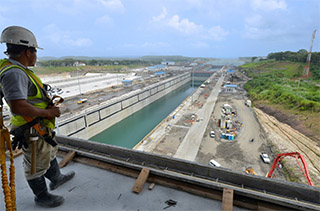A worker on the Panama Canal expansion looks out over construction. Panama Canal Authority photo.Almost two years overdue from its projected opening date, the Panama Canal is now scheduled to open its enlarged locks and usher through some of the world's largest container ships beginning in June.
This will be one of the most anticipated, studied and hyped events in global shipping and engineering when it finally gets underway Sunday, June 26. Since the expansion project began in 2008, it has been dogged by delays, contractural disputes, and staggering cost overruns to the tune of $5.25 billion.
The expansion is being closely watched by U.S. ports, inland barge operators, bluewater shipping companies and U.S. agriculture producers. They hope that the efficiencies brought by the use of bigger ships traversing the canal will drive down transportation costs and result in a surge in demand for their services and products.
As the theory goes, the larger vessels transiting the canal — which connects the Atlantic and Pacific oceans — will increase the volume of trade between the U.S. and Asia. A 2013 study by the Maritime Administration said expanded canal capacity will boost U.S. grain exports, as well as exports of coal, oil, petroleum products and LNG, "especially if U.S. Gulf ports are able to handle larger vessels."
Many predict a shift in shipping routes, with the West Coast losing its domination of Asian container business to East Coast ports that are gearing up for new business. About 70% of today's U.S. container traffic from Asia passes through Pacific ports. A wider canal will give shippers the option to bypass West Coast ports and their more pricey overland supply routes in favor of Atlantic ports like New York, Baltimore and Norfolk, Va. In fact the expansion has set off a so-called "race to the bottom" among competing ports to get their port drafts, warehousing and infrastructure ready to receive the Post-Panamax vessels, which are 235’ longer and 45’ wider than the current Panamax fleet.
It's not yet clear just how these shipping routes might change — there are lots of conflicting theories on that — and exactly which ports and how much U.S. agriculture and inland barging will benefit. A lot will depend on how the economics play out, including the fees the canal will charge these mega ships to transit the modernized facility.
Soybean producers have studied the impact on their commodity, and believe that good things are in store for them, inland waterways and Gulf Coast ports. About one billion bushels of a typical four billion bushel harvest are shipped yearly down the Mississippi River by barge to the Gulf of Mexico. Most of this is loaded on ships that will transit the Panama Canal en route to Asia.
An analysis done a few years by the Soybean Transportation Coalition concluded that the expansion will allow vessels at southern Louisiana export terminals to be loaded with at least an additional 500,000 bushels of soybeans, which equates to $5 million to $8 million in additional value per vessel. A soybean customer in Asia, it says, could save 35 cents per bushel simply due to greater transportation efficiency.
This will put more demand on the inland waterways to move commodities. "The demand for barge loading facilities along our major rivers will likely increase," according to the coalition.
The inauguration will be a huge international story when it happens in June. But let's not lose sight of another important story — the need to continually improve the locks and dams along the U.S. inland waterways.
In an increasingly interconnected world, efficient operation of U.S. navigational infrastructure is essential to the smooth movement of global trade, but also for the seamless flow of commodities in the domestic market.





